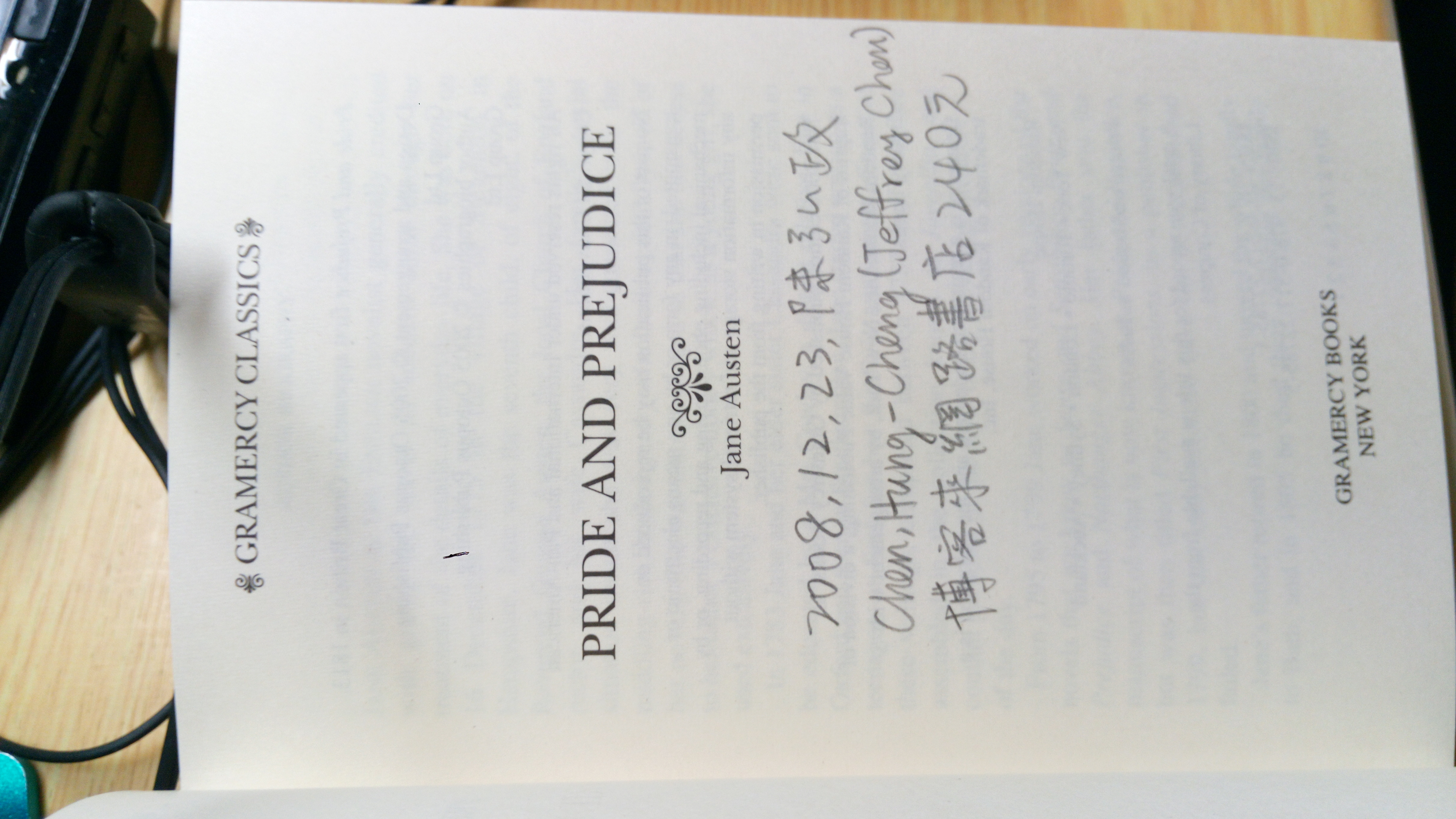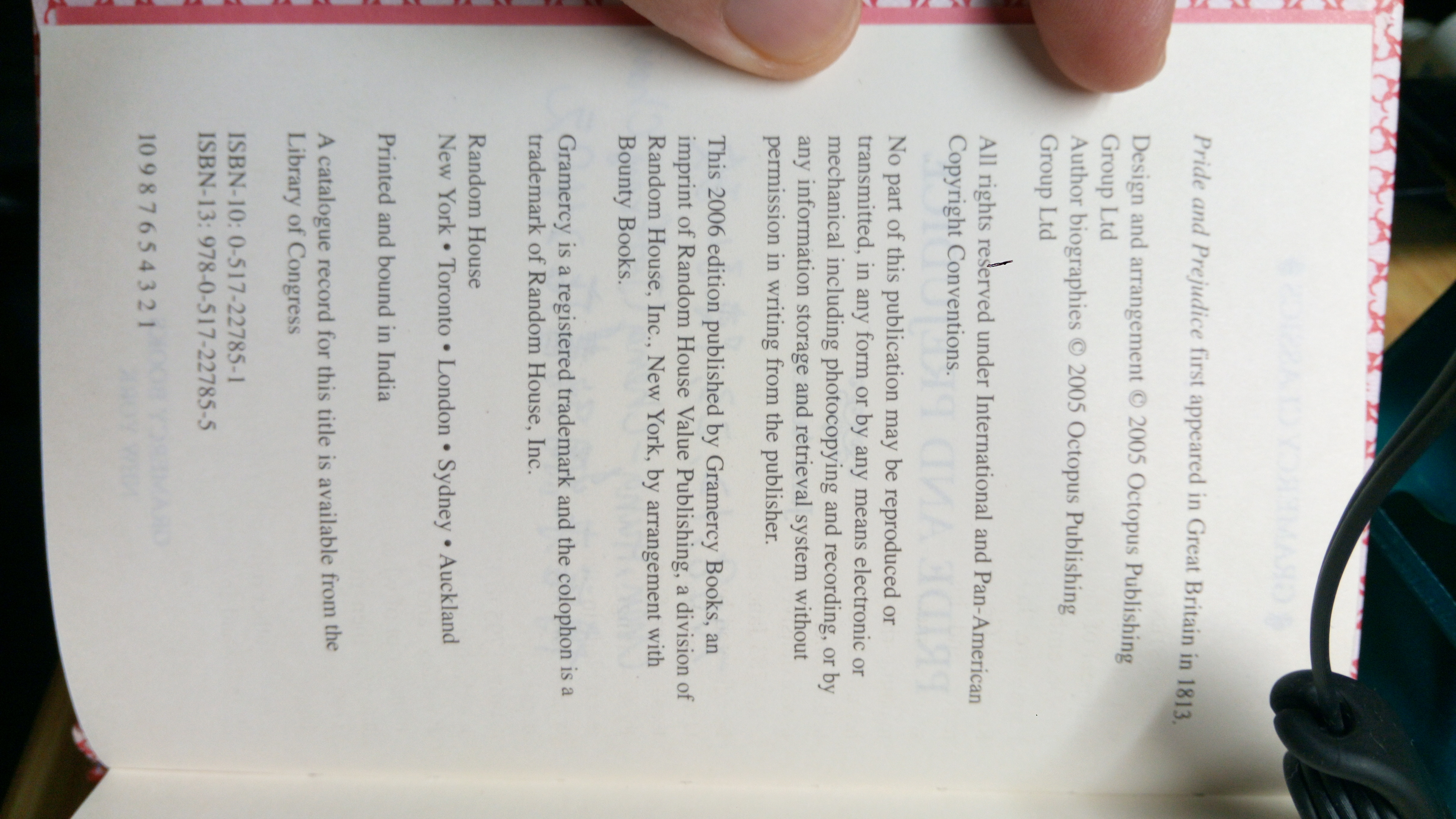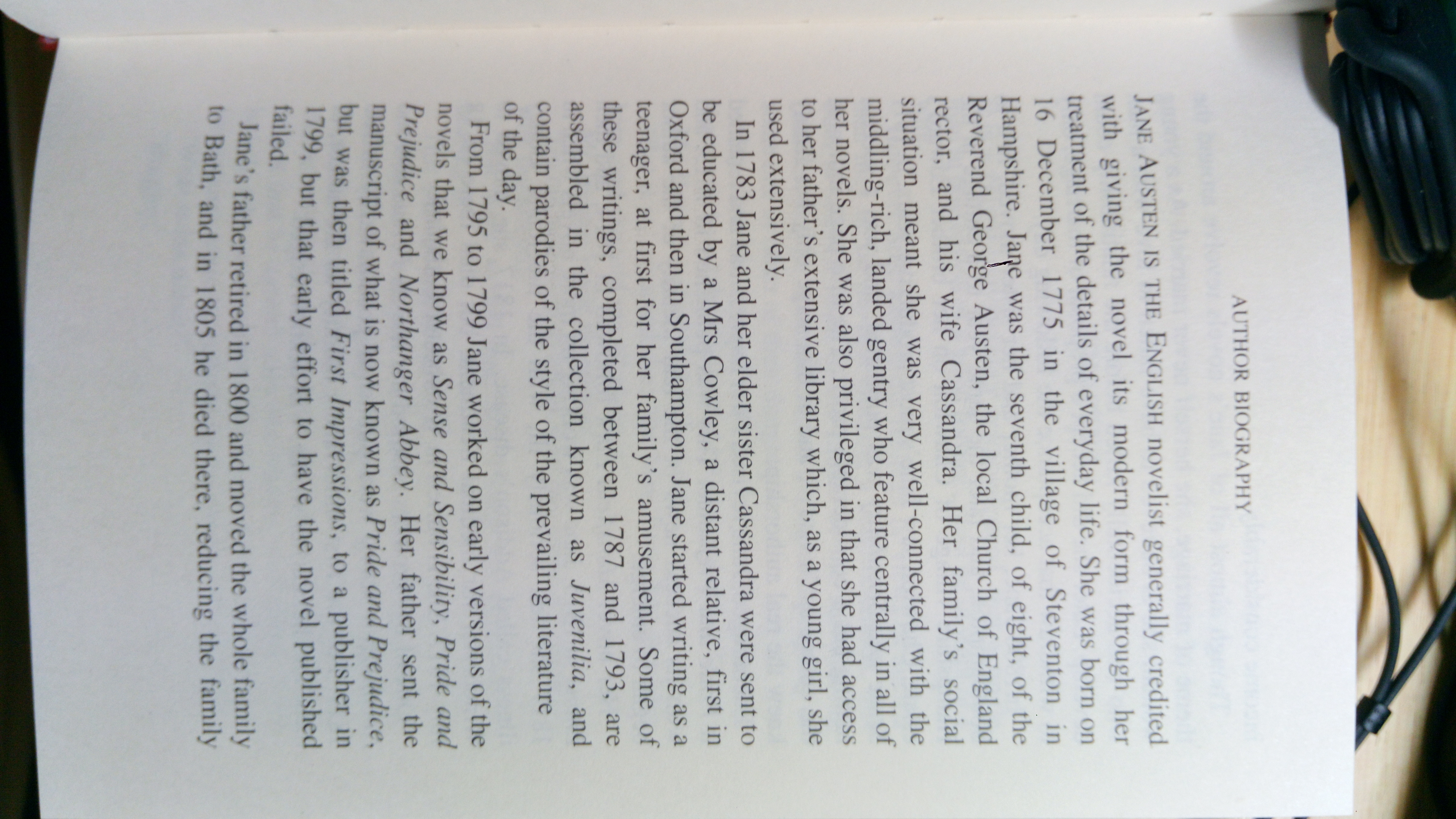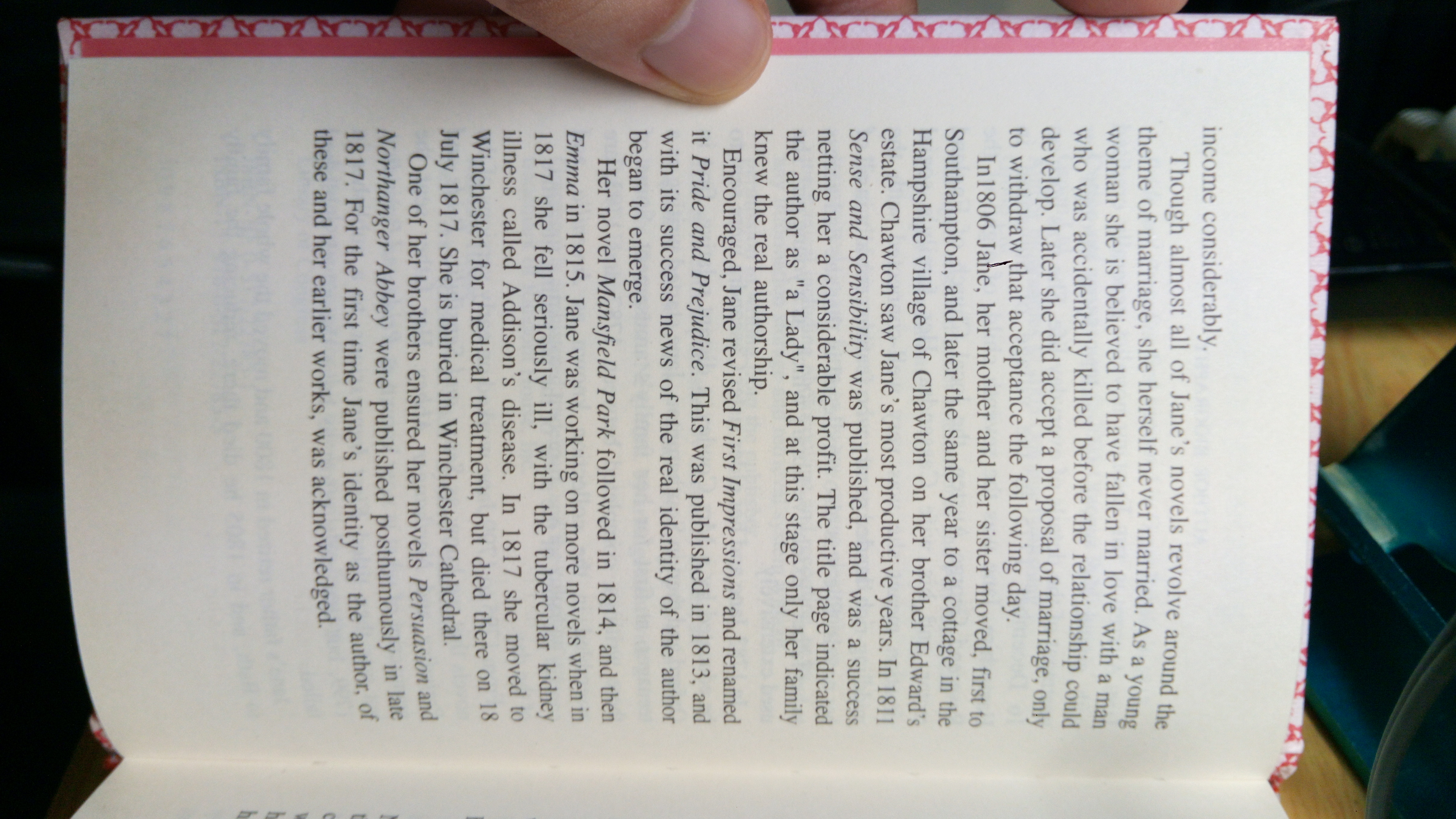

 字體:小 中 大
字體:小 中 大 |
|
|
|
| 2018/05/12 01:35:47瀏覽59|回應0|推薦0 | |
Jane AustenA puzzle inside an enigmaCults, cultures and oneupmanshipJul 21st 2012 | from the print edition What Matters in Jane Austen? Twenty Crucial Puzzles Solved.By John Mullan. Bloomsbury; 342 pages; £14.99. To be published in America in January; $30.Buy from Amazon.com, Amazon.co.uk Jane Austen’s Cults and Cultures.By Claudia Johnson. University of Chicago Press; 240 pages; $35 and £22.50.Buy fromAmazon.com, Amazon.co.uk JANE AUSTEN wrote six novels, lived quietly in Hampshire and died at the age of 41, having enjoyed moderate success. Since then, a cult of “Janeism” has ensured her legacy, and she has become one of the most widely read and revered 19th- century novelists. Two new books explore the passion and proliferation of Janeism in different ways. John Mullan (an unapologetic Janeite) takes delight in a close reading of her works, and Claudia Johnson (a Janeite with objectivity) traces the development of Janeism from the late 19th century to the present day. In this section · »A puzzle inside an enigma · Amazon Mr Mullan, an English professor at University College London, manages to make literary criticism fun. In “What Matters in Jane Austen?” he solves 20 crucial puzzles by asking such questions as “Is there any sex in Jane Austen?” and “Why is it risky to go to the seaside?”, scouring her oeuvre for clues and providing answers within the social context of Georgian England. This book provides entertaining trivia for Austen fans, who will be entranced by Mr Mullan’s encyclopedic knowledge of the texts and the times in which she lived. He takes pleasure in “becoming as clever and discerning as the author herself”. The best chapters are those in which Mr Mullan relates a theme in the novels to social history—moments that modern readers might otherwise miss. Thus, Austen never features or gives voice to the lower classes and servants. Readers might not see them, but by observing the dialogue and other characters’ manners it is clear that they are there. Contemporary readers, though, would be familiar with servants being present, and would sympathise, for example, with Elizabeth Bennet’sfrustration at her mother gossiping in front of them in “Pride and Prejudice”. Playing games is also significant. Modern-day readers may not intuit the set-up of card tables, but they are a useful trick for Austen to push characters together and manoeuvre others away (all in the name of courtship). She also passes subtle judgments on the common practice of gambling. The chapter on money is revealing, since wealth and inheritance were inextricably tied to social standing and the all-engrossing business of getting married. Like Mr Mullan’s, Ms Johnson’s book, “Jane Austen’s Cults and Cultures”, shows that the novels demand rereading and can be interpreted in many ways. Also an English professor, at Princeton University, she writes in a more academic style, taking in research by fellow critics and Austen-related literature covering the broad periods of the late 19th century, the first and second world wars and the present day. At times the reader may feel that the library stacks are closing in, but there are some revealing passages that show how changing culture invites reinterpretation of Jane Austen and her works. The opening chapter on Austen’s body and her image is the most memorable. Few pictures of Austen survive, and over the decades she has been re-imagined in paintings, books, plays and films. Her place and meaning in culture have also shifted as society has changed. The Victorians saw magic in her stories; disenchanted with modernism, they aligned her novels with fairy tales and an idealised England. In the first world war soldiers carried her books to the front line as companions in a terrifying conflict, perceiving peril in the pages and toughness in her words. During the second world war Austen was considered the epitome of Englishness, part of the restful home front that needed protecting. Both books are important. Ms Johnson’s essays offer the reader a fuller appreciation of Austen and her admirers, but it is Mr Mullan’s you should read for an unforgettable lesson in one-upmanship over your fellow Janeites. from the print edition | Books and arts · Recommended · 2 · inShare0 Related itemsAmazon »· Money and the markets: Insatiable longing · Rehabilitating capitalism: For those who have lost faith · The success of hedge funds: Masterclass Jane Austen »· Zombie films: Invasion of the living dead · English literature: No plain Jane Want more? Subscribe to The Economist and get the weeks most relevant news and analysis.
A puzzle inside an enigma Jul 30th 2012, 15:23
I once read the classics written by Jane Austen (Dec. 1775- July 1817), who is regarded as the first writer of modern English literature and whose locution was seen as the beginning of that. The most influential writings is “Pride and Prejudice”, whose movie version has been put forward in 2005. Also due to her sentiment of human behaviour sharper than almost of English writers in recorded history, for me, she is the greatest novelist of the 19th and 20th centuries.
Surrounded by French pianist Jean-Yves Thibaudet’s beautiful sound with outstanding Italian Dario Marianelli’s composition, enjoying “Pride and Prejudice” helps rationalize, in common, the upper sentimental emotion in 18th century. Besides, her first novel “Sense and Sensitivity”, once filmed by Lee Ann, successfully depicted two sisters as the reflection or facets of various personalities.
After these above two, she wrote “Northanger Abbey”, “Mansfield Park”, “Emma”, “Persuation” affecting the numerous readers of the world. Taking some letters written by her into consideration, some sentences still last, such as “She was a woman of mean understanding, little information, and uncertain temper” (from “Pride and Prejudice”), “Young ladies should take care of themselves. Young ladies are delicate plants. They should take care of their health and their complexion. My dear, did you change your stockings?” (from “Emma”) and “I do not want people to be very agreeable, as it saves me the trouble of liking them a great deal.”(From her letter) She always observes, analyzes as well as decipher all she sees, recognizes and intrigues without covering up for the real sensation.
Although she had few formal education with a terrible father, still, her profound imagination emerges fruitfully awakening people to reorganize the way of relationship with each other. Since she was very young, she read extensively and critically in terms of many fields. At her age of 13, she was already writing amusing and instructive parodies and variations on 18th-century literature—from sentimental novels to serious histories. During her short life, she lives in a plain life with somewhat unfortunate.
Until these two book’s presence, there has been already some researches about her life compared with her writings while getting ideas of expression, which could turn to another formation. The sentence structure which she deduced debuts the modern English language. From the contemporary Englishs point of view to see these classics, some blunt or uncomfortable feeling may occur as the difference of grammar between the early 19th and presence. Well, the arrangement of words is less important and trying to reshape them from word to sentence and to paragraph is more emphasized as the curious attitude toward relatively deriving issue of Jane Austen. Jane’s literate always looks fantastic. For two centuries, Jane Austen’s locution constantly remain in English world, worthy of studies as Chinese Tsaou Shuae-qin’s (1724-1763) “Stone Story” which told an everlasting love. Now there are two more books discussing Jane Austen concerned in the Economist, for a rest of place, while international affairs make people nervous and busy. More enigma accompany more surprising idea of point - feeling Jane Austen’s charisma.
Recommended 4 Report Permalink 筆者那週挑了Books & Arts的其中一篇稍微曾經小有研究過的文學批評。說到Jane Austen,就是「Pride & Prejudice」和「Sense & Sesitivity」這兩本書及其實際生活悲慘又堅強的一面。筆者手邊的是Random House的分支Gramercy Books 的Gramercy Classics小硬裝24k冊子版本「Pride & Prejudice」(照片中是本書導言和作者介紹)。這本就筆者而言是現代英國語文的文學小說的濫殤,及標準語體和文法。在筆者讀高中的時候,北一女中的其中一年暑假作業是看一小段的篇章,並寫出英語的心得感想。這兩本都是不錯的角度,在繁忙的生活中要一窺數本Jane的經典,可謂撫慰了無數漂泊的心靈。 Jane沒有受過多少的正式教育,而能夠在從詼諧小說到嚴肅的歷史討論的語言世界裡,有很廣博的知識和內涵,真情流露其性格。讀她的小說總是能點到真誠,而感受其璀燦絢麗的人生。有的篇章反映她自己對人生意義的看法,有的段落影射其真實的困苦卻能自得的生活。無論如何,她的文章和語氣已是英語世界中僅次於聖經,而最能夠流傳至世界各地的悲喜情緒而千里飄香。筆者特別在當年這個經濟學者雜誌的討論區舉例,幾乎同一的世紀的中國清朝盛世間的曹雪芹先生的石頭記(紅樓夢)和Jane相互輝映照亮東西方的人性憂愁,於是筆者再拿起了這本小冊子,並且列出微軟百科全書對Pride & Prejudice的說明,分享給大家。(2018,07,12補充) Microsoft Encarta 2009對Jane Austen生平的描述 Jane Austen (1775-1817), English novelist, noted for her witty studies of early-19th-century English society. With meticulous detail, Austen portrayed the quiet, day-to-day life of members of the upper middle class. Her works combine romantic comedy with social satire and psychological insight. Two common themes in Austen’s books are the loss of illusions—usually leading characters to a more mature outlook—and the clash between traditional moral ideals and the everyday demands of life. In most of her novels, her characters correct their faults through lessons learned as a result of tribulation. Because of her sensitivity to universal patterns of human behavior, many people regard Austen as one of the greatest novelists of the 19th and 20th centuries. Life Austen was born in Steventon, Hampshire, England. She was the seventh child of eight, and her family was close, affectionate, and lively. She lived most of her life among the same kind of people about whom she wrote. Her lifelong companion and confidant was her older and only sister, Cassandra. Neither woman ever married, but dozens of relatives and friends widened Austen’s social experiences beyond her immediate family. The Austens frequently staged amateur theatricals, and they were devoted readers of novels at a time when reading novels was regarded as a questionable activity. They also provided a delighted audience for Jane’s youthful comic pieces, and later for her novels. Jane had almost no formal education, but she read extensively and critically. At age 13 she was already writing amusing and instructive parodies and variations on 18th-century literature—from sentimental novels to serious histories. By the time she was 23 years old, Austen had written three novels: Elinor and Marianne, First Impressions, and Susan, which were early versions of, respectively, Sense and Sensibility (1811), Pride and Prejudice (1813), and Northanger Abbey (1818). A fragment, Lady Susan, which scholars date between 1793 and 1795, most likely also belongs to this period, but it was not published until 1871. In 1801 the family moved to the town of Bath. After Jane’s father died in 1805, Jane, Cassandra, and their mother moved several times, eventually settling in 1809 in the village of Chawton, very near Steventon. Austen lived and wrote there for the last eight years of her life. All of Austen’s novels were originally published anonymously. Several of them went through two editions in her lifetime. Pride and Prejudice was particularly praised, and Emma (1816) received a favorable review from English writer Sir Walter Scott, who was a prominent literary figure of the time. Early Works After her literary experiments as a teenager, Austen had two periods of busy and fruitful writing. The first lasted from 1795 to 1798. During this time she wrote the first versions of Sense and Sensibility, Pride and Prejudice, and Northanger Abbey. Austen’s family preserved the writing she did as a teenager, which was published more than a century after her death as Love & Freindship and Other Early Works. It includes the story “Love and Freindship” [sic], which Austen completed when she was about 15 years old. It is a comic parody of 18th-century melodramatic fiction. The main theme of Austen’s first full novel, Sense and Sensibility, is that sensibility—responsiveness, openness, enthusiasm—is highly desirable, but that it must be tempered by good sense and prudence. In other words, a person needs both sense and sensibility for fulfillment and survival. Nineteen-year-old Elinor Dashwood, the elder of the two sisters at the center of the story, combines both qualities; her 16-year-old sister, Marianne, is less balanced. The novel focuses on the romantic affairs of the two sisters. When Marianne sprains her ankle on a hillside in a rainstorm and handsome John Willoughby rescues her, she follows her heart and passionately responds to what she believes is his courtship. He, however, breaks off the relationship when he learns that Marianne is not rich. In the meantime, Elinor becomes involved with a young man of integrity, Edward Ferrars, who, unknown to her, in a foolish moment of his youth had become secretly engaged to a woman whom he did not love. Both heroines suffer, but Elinor bears her suffering stoically while Marianne dramatizes hers, playing the role of the jilted maiden. Elinor is ultimately rewarded with a happy marriage to Edward while Marianne eventually accepts the proposal of the dull though loyal Colonel Brandon. In Sense and Sensibility Austen challenges her readers and her characters to look closely at all facets of an individual’s personality. In so doing, Austen has been criticized for creating characters who are morally good, but too flawed to be appealing. For instance, Elinor may strike an ideal balance between sense and sensibility, but she also can strike the reader as cold and judgmental. Austen recognized that real people are flawed in significant ways, and so she did not permit the characters in her romances to drift too far from life. Pride and Prejudice is Austen’s first undoubted masterpiece. The book focuses on the Bennet family and the search of the Bennet daughters for suitable husbands. Austen illuminates the topic of husband hunting and marriage in an acquisitive society and shows most of its aspects and consequences—comic, trivial, sensual, opportunistic, desperate, and hopeless. The story follows Elizabeth Bennet and Fitzwilliam Darcy, both of whom are romantic and intelligent, as they are forced to give up their personal pride and prejudices before they can enter into a happy relationship together. As do Austen’s earlier writings, Pride and Prejudice displays the themes of appearance versus reality, and impulse versus deliberation. Elizabeth, trusting her own impulses, makes a mistake about Darcy and his apparent arrogance that deliberation and further experience eventually cause her to correct. Of Elizabeth, Austen wrote: “I must confess that I think her as delightful a creature as ever appeared in print, and how I shall be able to tolerate those who do not like her...I do not know.” In contrast to Elizabeth, her father, Mr. Bennet, is the book’s example of what it means to live with one’s mistakes. When he was courting Mrs. Bennet, her beauty blinded him to her silliness. Another character, Charlotte Lucas, scared of spinsterhood, deliberately chooses to ignore personal desire and the basic requirements of a good marriage according to every Austen novel—friendship and respect—and she marries for security and social status only. Northanger Abbey—the novel originally titled Susan—parodies the exaggerated, mystery-filled and horror-filled Gothic novel form. The story is about Catherine Morland, a gullible and naive girl who enjoys reading Gothic novels. With the help of Henry Tilney, Catherine learns that real-life villains, specifically Henry’s social-climbing father, are characterized by mundane nastiness rather than melodramatic Gothic violence, and that extremely charming people, specifically Catherine’s friend Isabella Thorpe, can withdraw their affections as quickly as they offer them. Northanger Abbey is a novel of sustained and sparkling inventiveness, displaying the accurate and ironic social and psychological observation that also shows up in Austen’s mature fiction. Later Works Austen’s second important period of writing lasted from 1811 to 1816, when her works first received public recognition and she deepened her mastery of her subjects and form. In this later period she revised and prepared Sense and Sensibility and Pride and Prejudice for publication, and wrote her last three completed novels, Mansfield Park (1814), Emma, and Persuasion (1818). (Austen had already revised Susan in 1803, but it was not renamed Northanger Abbey and published until 15 years later.) Mansfield Park is Jane Austen’s most ambitious novel—in length, in variety of characterization, and in the scope of its theme. It centers on the effects of upbringing on personal morality in three families—the middle-class Bertrams, the fashionable Crawfords, and the impoverished Prices. Austen has been praised for her presentation of the complex relations between the members of the families, but as in Sense and Sensibility, she frustrates the expectations of her readers that the hero and heroine be vital, attractive characters. Fanny Price is intelligent, true to her values, and sensitive, but she is also frail, self-pitying, and terribly shy. “Creepmouse” is the label the character Tom Bertram pins on her. Edmund Bertram is witty and attractive when he is allowed to be, but circumstances usually keep him on the defensive, and he often seems prim and judgmental. Fanny and Edmund are, however, destined for one another, and after difficulty and growth on both their parts, they end up marrying. Mary and Henry Crawford, on the other hand, who were raised in London high society by an aunt and uncle who loved them but were not much concerned with their moral education, possess the vitality and charm expected in a hero and heroine. Some people have argued that Fanny and Edmund should have married Henry and Mary, thus combining morality and vitality. Others maintain that Fanny and Edmund are warm, wonderful people who make a perfect match, and that while Mary and Henry might be attractive, they are irredeemably shallow. An important topic in Mansfield Park, as in Persuasion, and to a lesser extent in the rest of Austen’s fiction, is religion. Near the end of the novel, Edmund Bertram is ordained a priest in the Church of England—in spite of Mary Crawford’s insistence that a career in the church is unchallenging and dull, unworthy of Edmund. The Anglican ministry, and its significance and importance (or lack thereof), are discussed several times in the course of the novel. Modern critics have asserted that Austen’s interest in heredity, education, economics, and social forces leaves no doubt that her fictional world is a modern one unconcerned with religious affairs. But some critics insist that the moral intensity of the novels strongly indicate a spiritual dimension to the stories. Critics see this dimension in the willingness of moderate and practical heroines to sacrifice their chances of worldly happiness rather than compromise their basic values, the constant emphasis on unselfish love and self-sacrifice, and the awareness of the limitations and mystery of the human mind and personality. The subject of the novel Emma is self-deception, and the book’s heroine is the personification of this subject. The novel follows the evolution of the lovely Emma from a domineering, self-infatuated meddler into a chastened young woman ready for marriage to the admirable and aptly named Mr. Knightly. He helps her to see herself more clearly and guides her away from a future as disastrously, and comically, muddled as her past. Emma is considered not as witty as Pride and Prejudice, and its heroine is not as appealing as Elizabeth Bennet. But Emma’s self-delusion, and the slow but progressive awareness by which she arrives at self-knowledge, give the novel a unity and perfection of form. Persuasion, Austen’s last completed work, is very different from its predecessors. The main character, Anne Elliot, at 27 years old, is older than any other Austen heroine, and the great romance in her life seemingly has taken place more than seven years before the novel begins. She had been courted by a dashing but penniless young naval officer, Frederick Wentworth, and had accepted him. Then, persuaded by a cautious older friend that the marriage would not work out well, she broke the engagement. Since the unhappy episode, Anne has led a life of almost total isolation. Anne’s mother, who shared her intelligence and sensitivity, died when Anne was 14. Her father, Sir Walter, and her two sisters are shallow, self-absorbed, and contemptuous of Anne. Only Anne’s inner strength and determination keep her from succumbing to self-pity and resentment. When Sir Walter is forced to lease his estate to an admiral returning from the Napoleonic Wars (1799-1815), Anne discovers that the admiral’s wife is a sister of the now promoted and wealthy Captain Wentworth. He thus reenters Anne’s life, but he still resents her having broken their earlier engagement and begins courting another, younger woman. Over time Anne and Wentworth are slowly drawn together again, and this time it is the man who learns from the woman that his values are askew, not the other way around, as in Emma. This subtle work follows the themes of chance and fate, and it shows a constant awareness of the mystery and frailty of human existence. Scholars debate how Austen’s deteriorating physical condition during the last year of her life affected her work. Persuasion has been called autumnal in its tone. Yet Sanditon, the novel she undertook a few months before her death and left unfinished, explores ambiguities of appearance and difficulties of judgment with a boldness of technique and a flexibility of tone that shows progress even from Pride and Prejudice and Emma. Several other incomplete works were published after Austens death. These include The Watsons (1923), Fragment of a Novel (1925), and Plan of a Novel (1926). Her correspondence has been published as Jane Austen’s Letters (1932; revised edition, 1952). Popular interest in Austen and her works increased during the 1990s, in part because of motion-picture and television adaptations of Sense and Sensibility, Emma, Pride and Prejudice, and Persuasion "Jane Austen." Microsoft® Student 2009 [DVD]. Redmond, WA: Microsoft Corporation, 2008.
Microsoft R Encarta R 2009. c 1993-2008 Microsoft Corporation. All rights reserved. Microsoft R Encarta R 2009. c 1993-2008 Microsoft Corporation. All rights reserved.
|
|
| ( 心情隨筆|心情日記 ) |














